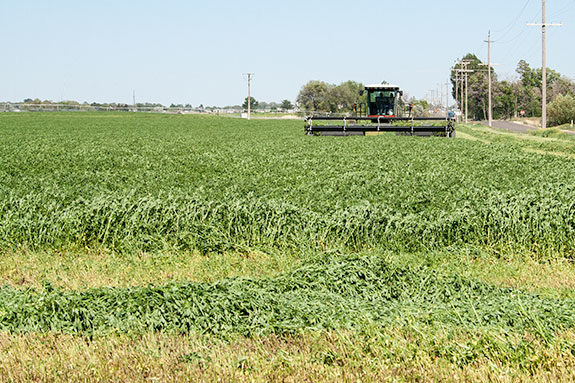This is because of many differing field factors, including maturity, age of stand (grass content), moisture, fermentation and palatability.
Since there are so many factors, growers need to focus on maturity, cutting timing and chop height in order to get the best quality.
Maturity matters
Nothing influences the nutritional value of alfalfa more than maturity, making this a high-priority focus for growers.
Similar to corn genetics, alfalfa genetics play a small role in quality differences, proving that the growing environment and harvest maturity are the biggest drivers in alfalfa’s nutritional value.
The four major environmental factors influencing alfalfa quality are temperature, water deficiency, solar radiation and soil fertility.
Increased temperature accelerates neutral-detergent fiber (NDF) development and lignification, which causes a decrease in quality and digestibility. This is one reason forages produced in northern altitudes tend to be higher quality: Those regions produce cooler nights.
While not good for yield, drought conditions are optimal for superior quality alfalfa because of increased protein and digestibility due to a higher leaf-to-stem ratio. However, dry conditions are usually accompanied by higher temperatures, which lead to increased lignification, jeopardizing quality. Hot and dry weather still makes the quality better than normal, but not as desirable as in cool drought conditions.
Solar radiation or light is the only environmental factor that promotes both yield and quality. Sunny weather provides light, which increases carbohydrate production, improving digestibility (good for quality) and photosynthesis (good for yield). And cloudy weather does just the opposite, decreasing both yield and quality. Yet in the fall, when daylight is diminishing, digestibility increases slightly and generates improved quality due to cooler temperatures.
To cut or not to cut?
Determining the best time of day to harvest alfalfa is challenging because many research results fall on both sides of this debate. Some growers believe they should cut later in the day because it allows the crop to lay down more sugars. This timing helps upgrade the hay’s palatability and aids in silage fermentation. However, morning and afternoon forages differ in initial composition, so whether these differences always exist after drying and/or fermentation is unclear.
When harvesting for silage, though, cutting in the morning is the way to go. Alfalfa mowed in the morning is usually ready in about nine hours for silage harvest, whereas alfalfa mowed in the afternoon is generally not harvestable until after noon the next day. By harvesting early in the day, growers are able to maximize the hours of drying and decrease the weather risks.
How low can you go?
By lowering the cutter bar, growers are bound to increase their alfalfa yields. But how low is too low? Research has shown that mowing to a one-inch to two-inch stubble height results in higher yields with little or no damage to the plant. This is because alfalfa plants regrow from the crown buds, not from the cut stems. But that is the lowest experts recommend growers mow when trying to obtain maximum yield.
On the other hand, an increase in yield must be balanced against the tendency for disc mowers to vacuum soil into the crop. Taking in soil lowers digestibility and increases the potential for soil-borne bacteria and spores that negatively affect fermentation.
For most producers 2.5 to three inches seems to be a good compromise height for cutting pure-alfalfa stands when balancing for maximum yield and minimum vacuuming. The exception to this is the final harvest of the season in regions with very cold winters. In this case, growers should leave four to six inches of stubble to ensure good insulation for the alfalfa crowns.
The final cut
Alfalfa is probably one of the most variable feeds on many operations when it comes to quality. This is due to field-by-field variations, such as harvest maturity, moisture, age of stand (grass content), fiber digestibility, fermentation and palatability. By watching for just the right plant maturity, determining the best cutting time and measuring the most efficient cut height, growers are bound to notice an increase in alfalfa quality. FG
PHOTO
Staff photo.










